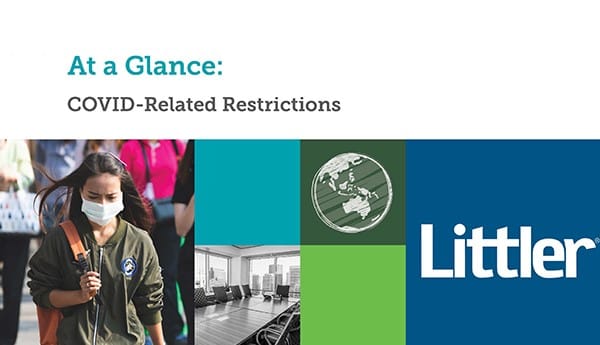 NEWS
NEWSThe year 2021 has been one of turmoil, transition, and uncertainty for so many industries and spaces. The world of employers has been no less dramatic. Beyond the list of ground-breaking cases, employers and HR professionals have faced a difficult year managing the coronavirus pandemic and its longstanding consequences on the workforce. There have been highs and lows, and in this article, we look at some of the most significant developments that impacted employers in 2021, before we turn our attention to those developments employers can be quietly optimistic about for 2022.
Highs and lows of 2021
Coronavirus, and the mandatory vaccination
The continued effects of the pandemic were always going to be inescapable this year. This remained just as true for employers. One of the most concerning issue employers faced were questions over vaccinations. With businesses eager to return to normality post lockdown and have employees come back to the office, there was a growing need for a fully vaccinated workforce amidst safety concerns. However, a blanket policy imposed by employers would almost certainly bring with it liability for discrimination and potential unfair dismissal for anybody dismissed for refusing to take the vaccine. Ultimately employers decided to adopt a more holistic approach to tackling Covid-19. Many employers focussed on encouraging voluntary vaccinations and doing everything to support workforce vaccination, including allowing for paid time off. Beyond this, employers were also required to tackle Covid-19 through ongoing risk assessments, designed to minimise the risk of transmission within the office.
Return of Gender Pay Gap Reporting
The Covid-19 pandemic put a brief hold on the penalties for not reporting on the gender pay gap for relevant employers. The legislation was delayed by the pandemic as non-compliance only become punishable this year. The legislation requires all companies with a headcount of 250 or more as at 5 April 2021 (or 31 March for all public bodies) to disclose their gender pay gap reports. The purpose of the legislation is to hold companies to account for the gender pay gap inequity that still exists, and businesses that produce less than favourable figures run the risk of brand damage, or the loss of present and future talent. Tackling the gender pay gap will go a long way to dismantling many of the barriers to progression women still face in their careers today.
Looking to 2022
Workplace sexual harassment
On 21 July 2021 the government published their response to their consultation on workplace sexual harassment. The consultation had been commissioned in 2019, and upon conclusion the government have committed to bringing in some new measures and responsibilities for employers in 2022. Firstly, the government intends to impose an active duty on employers to prevent sexual harassment at the workplace. Employers can of course already be vicariously liable for incidents of sexual harassment by employed staff, unless they can show that they have taken “all reasonable steps to prevent this”. However, under the new duty, employers could potentially be held accountable for failing to take preventative steps even if no incident had yet occurred. The government are yet to confirm whether these new duties will be imposed on just sexual harassment, or all forms of harassment in the workplace. The government also intends to bring in reform which will allow sexually harassed employees to bring an action against their employers for harassment they face at the hands of third parties (clients, customers, suppliers etc). This consultation response should prompt employers to re-evaluate their harassment policies to ensure that they are doing enough and won’t fall foul of these government changes. Training and awareness will be central to communicating the message throughout the workforce, including for those who are working remotely.
Making flexible working the default
The end of this year saw the government close the response deadline to their consultation on flexible working proposals. Under the current legislation employees have the right to request flexible working only after the first 26 weeks of their employment. Prior to the pandemic, cultural working expectations meant that this was an option far less likely to be exercised by employees due to fears it could limit opportunities for progression, create gaps in work distribution and lead to coordination issues. The new measures will seek to make flexible working the default by making the right to request available to employees from day one, reducing the employer response time to flexible working requests and requiring employers to consider alternatives when turning down employee requests. These changes will likely make the requests for flexible working far more common, but true normalisation will only come through cultural shifts which can’t be legislated against. The response to the pandemic has gone a long way to help normalise flexible working, with 47% percent of the UK working from home when mandated to by the government, and most of the workforce believing a hybrid is the preferential mode of working. It is hoped the legislative updates will work in tandem with shifting attitudes towards flexible working, to help make it the norm in 2022.
The Employment Bill
In the Queen’s Speech of December 2019, the Government outlined proposals for the introduction of a new Employment Bill to incorporate the changes recommended by the Good Work Plan. The Good Work Plan suggested a multitude of reforms that were put forward to the government after the extensive 2017 Taylor review of employment practices in the UK. The employment bill is set to come with a host of changes including:
- The establishment of a new single enforcement body for employment rights;
- The extension of protection against redundancy for pregnancy, maternity, adoption, and shared parental leave, including extending redundancy protection to six months post return to work after the end of maternity leave, with similar protection afforded to those returning to work from adoption leave and shared parental leave;
- Neonatal leave and pay;
- A new right to one week’s unpaid leave per year for carers;
- New legislation making it compulsory for organisations to publish their modern slavery statements on a new government-run registry;
- New legislation to ensure that tips left by customers in restaurants are retained by staff in full, and are not either partially or wholly taken off them by their employers;
- A new right for workers to request a more stable contract after 26 weeks service;
- New legislation to enhance flexible working rights;
- An extension of time required to break a period of continuous service from one week to four weeks.
There is no indicator of exactly when in 2022 this bill may be produced, if at all, but when it does arrive, it will certainly shake things up drastically in the employment sphere.









